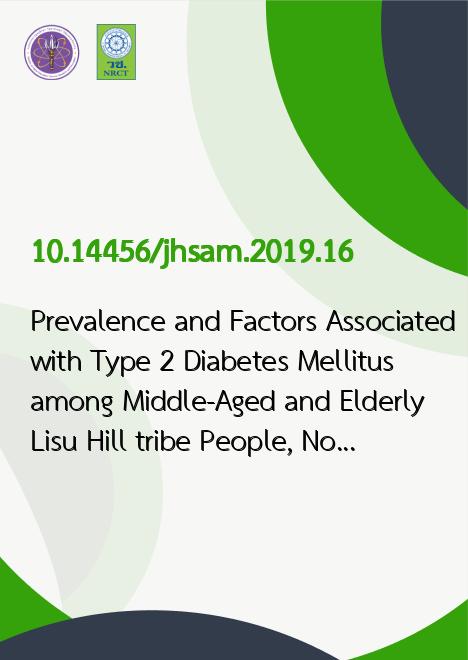
|
Prevalence and Factors Associated with Type 2 Diabetes Mellitus among Middle-Aged and Elderly Lisu Hill tribe People, Northern Thailand: A Cross-sectional Study |
|---|---|
| รหัสดีโอไอ | |
| Creator | Chalitar Chomchoei |
| Title | Prevalence and Factors Associated with Type 2 Diabetes Mellitus among Middle-Aged and Elderly Lisu Hill tribe People, Northern Thailand: A Cross-sectional Study |
| Contributor | Tawatchai Apidechkul, Siriyaporn Khunthason, Niwed Kullawong, Vivat Keawdounglek, Ratipark Tamornpark, Panupong Upala, Fartima Yeemard, Chanyanut Wongfu |
| Publisher | School of Health Science Mae Fah Luang University |
| Publication Year | 2562 |
| Journal Title | Journal of Health Science and Alternative Medicine |
| Journal Vol. | 1 |
| Journal No. | 3 |
| Page no. | 17-23 |
| Keyword | Prevalence, associated factors, type 2 DM, Lisu, hill tribe |
| URL Website | https://www.tci-thaijo.org/index.php/jhealthscialternmed/article/view/226570/160455 |
| ISSN | 2673-0294 (Online) |
| Abstract | Introduction: Type 2 diabetes mellitus (T2DM) is one of the most significant noncommunicable diseases (NCDs), and it is considered a major health threat for humans globally. Hill tribe people live in poor economic conditions, have low educational attainment and are vulnerable to T2DM, particularly the Lisu people, who have unique lifestyles and cooking styles. Objective: This study aimed to estimate the prevalence of and determine the factors associated with T2DM among the Lisu people aged 30 years and older in Chiang Rai Province, Thailand. Methods: A cross-sectional study was applied to collect information from Lisu participants aged 30 years and older who lived in five randomly selected Lisu villages in Chiang Rai Province. A validated questionnaire was used to collect information, and 5 mL blood specimens were drawn for laboratory testing. Data were collected in May-November 2018. Logistic regression was used to detect associations between variables at a significance level of a=0.05. Results: A total of 282 Lisu people were recruited into the study; 61.3% were females, 69.5% were aged 40-69 years, and 72.7% were Buddhist. The majority were illiterate (74.1%), agriculturalists (57.4%), and had a family income of less than 50,000 baht per year (70.9%). The total prevalence of T2DM was 18.1%; 8.9% had a medical history of T2DM. Among those who had no medical history of T2DM, 10.1% were detected as new T2DM cases. After adjustments were made for age, sex, income, and marital status, only waistline measurements were found to be associated with T2DM among the Lisu people in Thailand. Those who had been identified as at risk for metabolic complications (?90 cm in males and ? 80 cm in females) had a 2.20 time higher likelihood (95%CI=1.16-4.16) of developing T2DM than did those who were normal. Conclusion: Effective public health screening for T2DM should be urgently implemented in the Lisu population in Thailand. Moreover, a proper public health intervention for both men and women who have waistline problems should be initiated. |